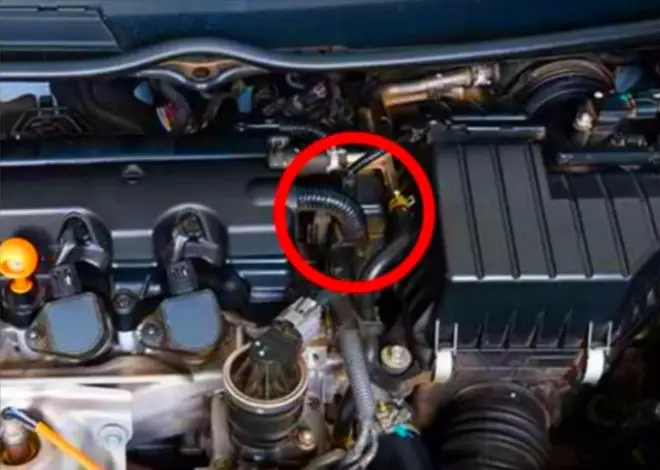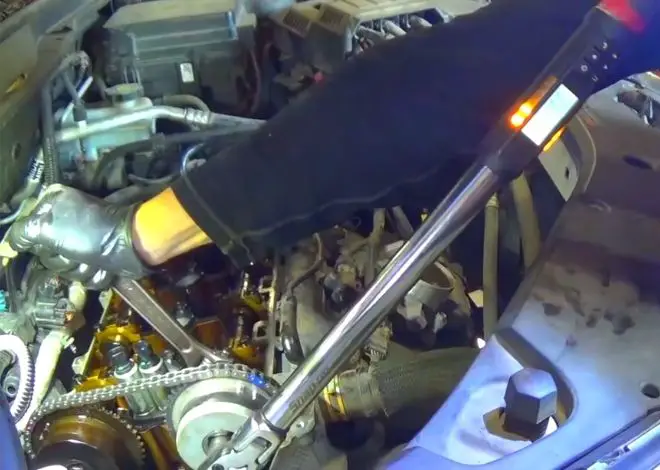Last Updated on April 22, 2025
What Does the P0016 Code Mean?
The P0016 diagnostic trouble code (DTC) stands for “Crankshaft Position – Camshaft Position Correlation (Bank 1 Sensor A)”. This error indicates a synchronization issue between the camshaft and crankshaft positions in Bank 1 of your engine. These two components must rotate in perfect harmony to ensure proper engine timing, efficient combustion, and overall smooth operation.
Modern vehicles rely on the PCM (Powertrain Control Module) to manage various engine parameters, including the rotation of the camshaft and crankshaft. The PCM monitors the position of these components using separate sensors—the camshaft position sensor and the crankshaft position sensor. If the PCM detects a discrepancy between the expected and actual positions of the camshaft and crankshaft, it registers the P0016 code and illuminates the check engine light (CEL) or malfunction indicator lamp (MIL).
This error code can significantly impact your engine’s performance and should not be ignored.
Common Causes of the P0016 Code
Understanding what causes the P0016 code is key to fixing it correctly. Below are some of the most common triggers:
- Misaligned timing belt or timing chain
- Worn-out timing components (chain, gears, guides, or tensioners)
- Stretched or loose timing chain
- Faulty camshaft or crankshaft position sensors
- Damaged or corroded sensor wiring or connectors
- Mechanical engine issues (e.g., worn camshaft gears or crankshaft keyway damage)
- Issues with oil flow affecting the Variable Valve Timing (VVT) system
- Slipped or damaged timing gear teeth
- PCM or ECM software issues or calibration errors
Each of these problems can disrupt the delicate balance between the crankshaft and camshaft, leading to a cascade of performance issues.
Quick Fix Guide (Causes & Solutions)
Causes:
- Misaligned or stretched timing chain/belt
- Faulty camshaft or crankshaft sensor
- Wiring damage or poor electrical connections
- VVT system malfunction
- Engine oil contamination or incorrect oil viscosity
- Defective camshaft phaser or OCV
- PCM issues
Solutions:
- Realign or replace timing chain/belt
- Replace defective sensors
- Repair or replace damaged wiring/connectors
- Flush engine oil and refill with manufacturer-recommended type
- Clean or replace oil control valve (OCV)
- Update or reprogram PCM software if necessary
- Inspect and replace timing-related hardware if worn or broken
Brands Commonly Affected by P0016 Code
This issue isn’t limited to one manufacturer. Vehicles from many well-known brands frequently encounter this trouble code. Popular examples include:
- P0016 Chevy
- P0016 Ford
- P0016 Dodge
- P0016 Mercedes
- P0016 Toyota
- P0016 VW
- P0016 Hyundai
- P0016 Nissan
Each manufacturer may have a slightly different interpretation and solution for this code, so always refer to vehicle-specific diagnostic procedures.
P0016 Bank 1 Sensor A Location
 The exact location of the sensors may vary slightly depending on your engine type and vehicle model. However, in most cases:
The exact location of the sensors may vary slightly depending on your engine type and vehicle model. However, in most cases:
- The Camshaft Position Sensor (Sensor A) is mounted on or near the valve cover and is aligned with the camshaft’s reluctor ring.
- The Crankshaft Position Sensor is usually located near the crankshaft pulley, often on the front lower side of the engine block.
These sensors continuously feed position data to the PCM. If they detect an irregularity, it triggers the P0016 code, which you’ll see via an OBD2 scanner.
In-Depth Causes of the P0016 Error Code
Let’s take a deeper look at what might cause this issue:
- Low or Dirty Engine Oil
Low oil levels or contaminated oil can interfere with the operation of the VVT system. This impacts the positioning of the camshaft and can trigger the P0016 code. - Stretched or Slipped Timing Chain/Belt
If the timing belt or chain stretches, skips teeth, or becomes misaligned, it disrupts the engine’s valve timing and causes a cam/crank correlation error. - Faulty Camshaft Phaser or OCV (Oil Control Valve)
These components help in adjusting camshaft timing. If they fail, the camshaft may not rotate correctly. - Sensor Problems
A failed camshaft or crankshaft sensor—or even a loose connector—can give the PCM incorrect signals. - Damaged Reluctor Ring
The reluctor (or tone) ring on the camshaft or crankshaft might be damaged or misaligned, giving false readings to the sensor. - PCM/ECM Issues
In rare cases, a software glitch or a damaged PCM could be the culprit.
P0016 Code Symptoms: What to Expect
When the P0016 code appears, you may notice one or more of the following signs:
- Illuminated Check Engine Light (CEL)
- Hard starting or failure to start
- Engine misfires or rough idling
- Reduced fuel economy
- Lack of power during acceleration
- Knocking or rattling noises from the engine
- Poor throttle response
- Failed emissions test
These symptoms can worsen if the issue is left unresolved.
How to Diagnose Error Code P0014?
Have you encountered error code P0014 on your vehicle? If not yet, knowing how to diagnose it will save you both time and money in the future. Diagnosing P0014 (Camshaft Position Timing Over-Advanced or System Performance Bank 1) can be a complex and sometimes expensive process if not approached correctly. This error code usually indicates issues with the camshaft timing, particularly with the Variable Valve Timing (VVT) system, which can affect your engine’s performance significantly.
Step-by-Step Diagnosis Process
- Start With an OBD-II Scanner
Use a reliable OBD-II scanner to check for trouble codes. Plug the scanner into your vehicle’s OBD port—usually located beneath the steering wheel—and run a scan. Take note if other codes appear along with P0014, such as P0011 or P0024. These may provide additional clues about the underlying issue. - Check Engine Oil Level and Condition
Low or dirty engine oil is one of the most common culprits behind code P0014. Inspect the oil level and quality. Old, sludgy, or incorrect viscosity oil can prevent the VVT solenoid from functioning properly. If necessary, perform an oil change with the manufacturer-recommended oil type and viscosity. - Inspect the Variable Valve Timing (VVT) Solenoid
The VVT solenoid is responsible for regulating the oil flow to the camshaft phaser. Use a multimeter to check for proper voltage and resistance. You can also remove and clean the solenoid if it’s clogged, or replace it if it’s malfunctioning. - Examine Camshaft and Crankshaft Sensors
Faulty sensors can send incorrect data to the PCM (Powertrain Control Module), triggering the error. Ensure both sensors are clean, properly connected, and functioning. - Analyze Timing Components
The next area to focus on includes:- Timing belt/chain
- Gears and sprockets
- Tensioners and guides
Wear or slack in these parts can cause timing to be off, which directly affects the VVT operation. Misalignment or tooth damage is a red flag.
- Check the PCM (Powertrain Control Module)
In some cases, a software-related fault or outdated programming in the PCM may be responsible. Consider performing a PCM update or reprogramming as recommended by your vehicle manufacturer. - Evaluate the Oil Control Valve (OCV)
The OCV regulates oil flow to the VVT mechanism. Ensure it isn’t stuck open/closed, leaking, or corroded.
Pro Tip:
Always record freeze-frame data before clearing the code. It will help you analyze under what conditions the error occurred, making the root cause easier to pinpoint.
How to Fix Trouble Code P0014?
Fixing error code P0014 isn’t just about clearing the code—it’s about addressing the root cause to prevent recurrence. Here’s a breakdown of the repair process:
1. Engine Oil Change
Replace dirty or degraded engine oil and use the correct oil viscosity. A high-quality synthetic oil is often recommended for engines using VVT systems.
2. Replace or Clean VVT Solenoid
A faulty VVT solenoid can’t control the camshaft timing correctly. Clean it with an appropriate solvent or replace it if it’s malfunctioning.
3. Repair or Replace Damaged Timing Components
Timing belt or chain issues can directly affect camshaft position. If you notice wear, broken teeth, or slack, replace the belt/chain and any affected components.
4. Replace Oil Control Valve (OCV)
If clogged or rusted, replace the oil control valve with a compatible OEM part. A damaged OCV can fail to regulate oil flow, triggering timing issues.
5. Fix Electrical Wiring
Inspect all connectors, terminals, and wires related to the camshaft position sensor, crankshaft position sensor, VVT solenoid, and PCM. Fix corrosion or broken wires immediately.
6. Update PCM Software
If all physical parts are functioning, a PCM software glitch might be the issue. Flash or update the PCM using manufacturer-approved software.
7. Reset the Code and Test Drive
After making the necessary repairs, use the OBD-II scanner to clear the code. Take the vehicle on a 15–20-minute test drive to ensure the code doesn’t return and to confirm the engine is performing normally.
How Serious Is the P0014 Code?
The P0014 trouble code is not one to ignore. If left unresolved, it can result in:
- Poor fuel economy
- Engine stalling or hard starting
- Rough idling and decreased power
- Severe engine damage due to incorrect valve timing
In extreme cases, the engine can suffer catastrophic failure, especially if the timing chain slips or the valves contact the pistons. Immediate attention is strongly recommended.
Common P0014 Diagnosis Mistakes
Avoiding common diagnostic mistakes can help you solve the issue more effectively. Here are a few to be aware of:
- Ignoring the Oil Quality
Many mechanics overlook old or low-quality oil, even though it’s one of the top causes of this code. - Overlooking Timing Components
Failure to inspect timing chain, sprockets, or guides can result in missed diagnoses. - Skipping Manufacturer-Specific Procedures
Vehicle manufacturers often provide model-specific test sequences or guidelines. Ignoring these can lead to incorrect repairs. - Not Checking Related Codes
Multiple DTCs may appear together. Fixing just one without addressing the others may not resolve the root issue.
Recommended Tools for Diagnosing P0014
You’ll need the following tools to properly diagnose and repair P0014:
- OBD-II Scanner with freeze-frame capability
- Multimeter or test light
- Basic hand tools (screwdrivers, wrenches, sockets)
- Fused jumper wires
- Vehicle-specific repair manual
- Oil pressure gauge (optional but helpful)
- Replacement engine oil and filter
Having these tools on hand will ensure a smoother diagnostic and repair process.
What Is the Estimated Cost of Repair?
Repair costs for P0014 can vary widely depending on the root cause and vehicle make. Here’s a general breakdown:
| Repair Task | Estimated Cost |
|---|---|
| Engine Oil & Filter Change | $40–$60 |
| VVT Solenoid Replacement | $300–$400 (parts & labor) |
| Oil Control Valve (OCV) Replacement | $150–$250 |
| Timing Chain/Belt Replacement | $500–$1,200 |
| PCM Reprogramming | $100–$250 |
| Complete Engine Replacement (if damaged) | $3,000–$4,500+ |
Labor costs may also vary based on your location and the auto repair shop’s hourly rate. Always get multiple estimates before authorizing expensive repairs.
Preventive Tips to Avoid P0014 Code
Preventing P0014 can save you hundreds—or even thousands—of dollars. Here’s how:
- Use only manufacturer-recommended engine oil and change it regularly.
- Inspect and replace your timing chain or belt at recommended intervals.
- Don’t ignore rough idling or sudden drops in fuel efficiency.
- Perform regular engine diagnostics with an OBD-II scanner.
- Follow scheduled maintenance in your owner’s manual.
Final Words
The P0014 code can lead to serious engine issues if left unresolved. While fixing it may seem intimidating, it becomes much easier when you follow a structured diagnostic approach. Start with basic checks like engine oil and move toward more advanced diagnostics like solenoid and timing system inspection.
If you’re uncertain or lack tools, always consult a certified technician to avoid costly mistakes. By acting early and smartly, you can restore your vehicle’s performance, extend its lifespan, and prevent future breakdowns.
Kevin Nicholas is an automotive technician who is a genius at software and hardware-related issues. He manually tested more than a hundred OBD scanners and gave his honest opinion on whether the device was worth the money or not. His in-depth OBD review articles help people choose the right product, whether it is a European, American, or Asian vehicle. He completed his Automotive Specialized Training Course at Universal Technical Institute and has more than 15 years of experience in the field.
